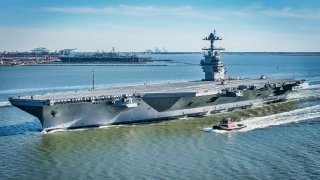The Navy's Ford-Class Aircraft Carriers: The Most Expensive Warship Ever
While the Ford program is presently way over budget, it was designed to cut costs in the long run. Many of the Ford’s new technologies were built to automate carrier operations, reducing its reliance on sailors—and sailors are, by and large, a carrier’s most expensive feature.
Summary: The Ford-class aircraft carrier, epitomized by the USS Gerald R. Ford, represents the pinnacle of naval engineering with its adoption of nearly two dozen new technologies, setting it apart as the most advanced and expensive warship ever constructed.

-Costing $120 billion to date, the program has exceeded its budget by 50%, primarily due to its innovative features like the electromagnetic aircraft launch system (EMALS).
-While the initial costs are high, the Ford-class carriers are designed to be more cost-effective over their operational lifespan by reducing crew size and maintenance requirements, potentially offsetting the steep upfront investment with long-term savings.
Ford-Class Aircraft Carriers: Breaking the Bank to Revolutionize Naval Warfar
The Ford-class aircraft carrier is the most advanced vessel of its kind ever built. With nearly two dozen novel technologies, the Ford sets a new performance standard.
Achieving that standard is a costly endeavor. To date, the Ford program has cost $120 billion. The first ship in the class, the USS Gerald R. Ford, cost a remarkable $13 billion.

The program was always expected to be expensive. But its $120 billion price tag is already $40 billion, or 50 percent, over budget. With more Ford vessels on the way, there are plausible concerns that the program cost will continue to soar.
Why So Expensive?
The Ford class is the most expensive warship ever built because so much of its technology is new. While the Ford does share some features with the preceding Nimitz class (the hull and some propulsion technology), most of its critical systems—including the launch catapult, arresting gear, elevators, electrical generation, and radar—are brand new.
When conceived, “the requirements for the new carrier class included being able to generate more sorties, launch and recover a wider range of aircraft and provide power for new radars and defensive weapons, some yet to be developed,” National Defense reported.

One of the technologies driving up program costs is the electromagnetic aircraft launch system (EMALS). This new system replaces the traditional steam piston catapult in use on aircraft carriers like the Nimitz and the Enterprise. The EMALS swaps out the steam piston for a linear induction motor that uses electric currents to generate magnetic fields. These glide an airframe along a track before launching it skyward. The EMALS is viewed as a marked improvement over steam catapults. It accelerates airframes more smoothly, which will cause less wear and tear on expensive jets like the F/A-18 and F-35. It costs less, weighs less, and requires less maintenance.

The EMALS also reduces the carrier’s dependence on freshwater, which requires an intensive desalination process. Finally, it recharges more quickly than steam catapults, meaning aircraft can be launched at a quicker tempo.
All told, the latest carrier features twenty-three new technologies.
Cheaper in the Long Run?
While the Ford program is presently way over budget, it was designed to cut costs in the long run. Many of the Ford’s new technologies were built to automate carrier operations, reducing its reliance on sailors—and sailors are, by and large, a carrier’s most expensive feature. They require food, housing, training, and healthcare. The Ford was designed to operate with about 1,000 fewer sailors than the Nimitz, which needed about 5,000 sailors. Across the Ford’s fifty-year service life, the ability to operate with far fewer sailors could reduce overall costs significantly.

So, while technology development has driven up the Ford’s budget in the short term, it might still save costs in the long run.
About the Author: Harrison Kass
Harrison Kass is a defense and national security writer with over 1,000 total pieces on issues involving global affairs. An attorney, pilot, guitarist, and minor pro hockey player, Harrison joined the US Air Force as a Pilot Trainee but was medically discharged. Harrison holds a BA from Lake Forest College, a JD from the University of Oregon, and an MA from New York University. Harrison listens to Dokken.
Images: Creative Commons.


